| For the latest news about FactSage 6.3 including items not presented here as well as a known 'bugs' and other issues go to www.FactSage.com > 'FactSage 6.3 ~ News ~' |
|
What's New in FactSage 6.3 |
(Revised May 2012)
The FactSage 6.3 Update/Installation program permits you to upgrade/refresh any version of FactSage to FactSage 6.3. You can also install FactSage 6.3 directly on to a new PC.
Major modifications and additions have been carried out. What follows is a list of the more important programming and database changes in FactSage 6.3 (2012) with respect to FactSage 6.2 (November 2010).
| For the latest news about FactSage 6.3 including items not presented here as well as a known 'bugs' and other issues go to www.FactSage.com > 'FactSage 6.3 ~ News ~' |
|
The setup program has been redesigned. Prior to 6.3 after downloading it was then necessary to extract/unzip all the files before running the installation program. In the FactSage 6.3 Update/Installation program this step has been simplified. The program now runs a self extractor that automatically performs the extraction operation before starting the installation.
|
In the FactSage Main Menu new options have been added to the Tools Menu
- click on 'Tools > ....' .
|
|
The top line of the Tools Menu summarizes the status of the FactSage installation.
The summary includes: FactSage version (6.3); customer ID (1 - 9999); type of installation (standalone, server or client); expiration date (month year, or perpetual).
In the FactSage Main Menu a 'FactSage databases summary option' has been added to the Tools Menu to display a Summary of All Databases installed on the PC.
The summary includes the type: Read-only (public) or Read/Write (private), compound or solution; the database file name; the version (5.0 ... 6.3); the expiration date and whether the file is accessible to you.
This 'Summary' information is already given in many of the programs - e.g. click on 'View Data > Summary'.
In the FactSage Main Menu a 'USB flash key (dongle) option' has been added to the Tools Menu that will enable you to you use a USB memory stick (for example Kingston DataTraveler 2.0 USB Device) in place of a MemoHASP security key (dongle).
The memory stick offers particular advantages over the dongle:
In the FactSage Main Menu a 'Reset programs option' has been added to the Tools Menu to display the Reset Window.
|
|
|
|
|
|
The slide shows on FactSage Applications in Chemical Processing and Alloy Design were presented at the Annual Montreal FactSage Workshop.
Over 100 new slides have been added to the Ferrous Metallurgy presentation. There are new slides on databases for steelmaking applications; phase diagrams for steelmaking applications; examples of Equilib for calculations of Target/Transition, Stream, Heat balance, Open, Fixing partial pressure, Fe saturation, etc; examples of Phase diagram calculations; activity calculations; Henrian activity coefficient; ideal solid solutions; multi-component phase diagrams, slag & refractories or inclusions non-metallic inclusions; solidification (Scheil cooling) of slag and steel refractory design (thermodynamic stability); and much more.
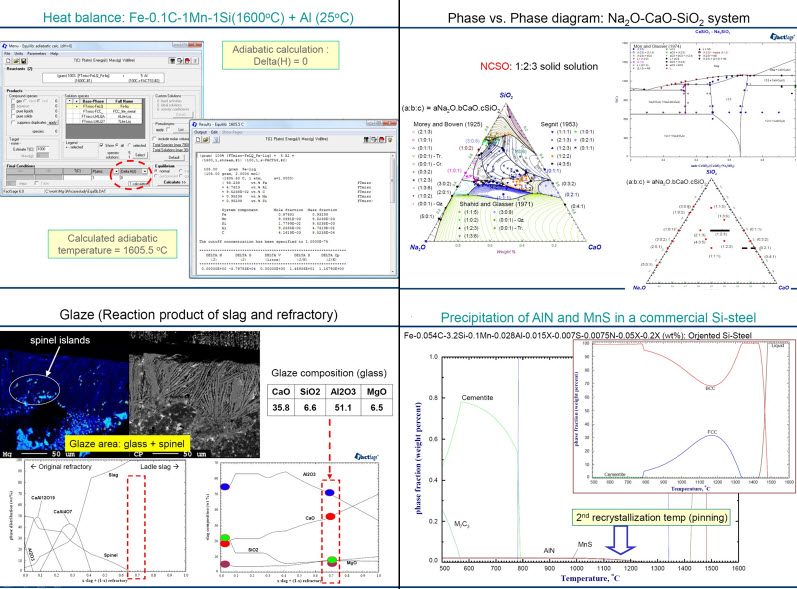
|
- called from 'General > FactSage-TEACH ...'. Prior to FactSage 6.3 FactSage-TEACH was sold separately. In FactSage 6.3 it is now part of the package.
|
|
FactSage-TEACH is a selftuition package on FactSage developed by GTT-Technologies. It is combination of a special handbook, a series of special mini-databases for use with the assignments, and a special flowsheet model for the Silicon Arc Furnace process. It is the result of a long series of seminars, training courses and workshops on Computational Thermochemistry which began in the early nineties using ChemSage.
For more information including the 'Table of Contents' click 'General > FactSage-TEACH > Introduction ...'. For the detailed manual click on 'General > FactSage-TEACH > Documentation ...'. <
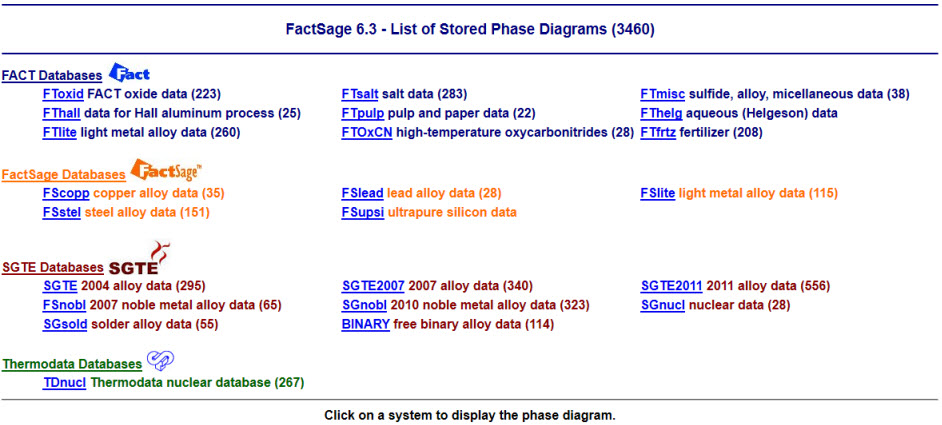
In FactSage 6.3 this can be done by a simple drag and drop operation. You click on the solid in the treeview, drag it over to the liquid phase and release the mouse button. A warning informs you of what is about to happen and you can accept (OK) or cancel the action.
If accepted all Cp expressions and ranges are copied from the solid to the liquid phase. The operation is limited to Cp expressions and does not copy the heat of formation nor absolute entropy at 298K, nor density, etc.
The copy operation of Cp expressions is not restricted to phases of a given compound. It can be carried out between different phases of different compounds stored in different databases.
|
The Solution Module cannot be run under Windows Vista or Windows 7.
This problem is not unique to 6.3 - it is present in earlier versions of FactSage.
For a possible remedy click on: 'Tools > FactSage running in Windows XP Mode ... '
|
|
DOCASE
The CASE statements within the DOCASE ... ENDDO commands now include a test for a range
('value1' TO 'value2') and a logical condition test (IS 'operator < > <> >= or <=' 'value').
New $Variable$s
New variables have been introduced into 6.3 macro processing.
SET OUTPUT
New output format commands for the display in the Results Window
SET SELECT
In FactSage 6.2 problems were encoutered with phase and species selection 'SET SELECT' commands of the type:
Calculated activities (moles, mole fractions, grams and Wt.% - click on Show to specify)
are listed in the species Selection Window.
Several changes and additions have been carried out to the display.
The screenshot displays the Selection Window gas phase results
for the adiabatic reaction (Delta H = 0):
A total of 99 pages were calculated where <A> = 0.01, 0.2, 0.03 ... 0.99.
Page 50 shown here corresponds to <A> = 0.50.
For the case of CO2(g) (species 26) it is seen that the activity (e.g. partial pressure) = 3.6974e-2 atm when <A> = 0.5
and that P(max) is 0.1402 atm at page 79 (where <A> = 0.79).
It is seen that the maximum adiabatic temperature is 2784.71 C
at page 65 (e.g. <A> = 0.65).
Minor changes have been made to the Predom/EpH module.
Bugs reported in FactSage 6.2 included 3-metal metallic ratios R1 and R2 could not be changed;
species unselected with the 'List' button were automatically reselected.
In FactSage 6.3 these have been corrected.
- bugs reported in FactSage 6.2 (see Predom above) have been corrected In FactSage 6.3.
- H2(g) and O2(g) labels have been added to the corresponding H2(g)/H2O and O2(g)/H2O lines
- the labels for charged ionic species have improved readability.
- called from 'Reactants Window > File > Macro processing > Run macro ...'
DO CASE %1
CASE 0 1 2 // If %1 has the value 0, 1 or 2
(macro lines)
CASE 3 TO 50.5 // If %1 is in the range 3 to 50.5
(macro lines)
CASE IS <= -100 // If %1 is less than or equal to -100
(macro lines)
CASE IS <> 1000 // If %1 is not equal to 1000
(macro lines)
CASE ELSE
(macro lines)
ENDDO
$TEMPDIR\ = temporary directory - environment variable defined by Windows
Extensive Property Changes:
$E_DOK$ = 'OK' when delta values calculated (e.g. initial conditions defined)
$E_DC$ = Delta Cp heat capacity
$E_DF$ = Delta Gibbs Free Energy
$E_DG$ = Delta Gibbs Free Energy
$E_DH$ = Delta Enthalpy
$E_DS$ = Delta Entropy
$E_DV$ = Delta Volume
Input Reactant Values:
$R_SOK$ = 'OK' when states are known (e.g. initial conditions defined)
$R_p*$ = phase state (1=gas, 2=liquid, 3=aqueous, 4=solid, 5=solution) of reactant *
$R_s*$ = short state (g, l, aq, s, s2) of reactant *
$R_S*$ = full state (gas, liquid, aqueous, solid, solid-2) of reactant *
Chemical and Physical Properties of Solution *:
$E_CP*_Evolts$ = aqueous Eh
$E_CP*_pH$ = aqueous pH
$E_CP*_total_molality$ = total solute molality
$E_CP*_ionic_strength$ = ionc strength
$E_CP*_osmotic_coeff$ = osmotic coefficient
$E_CP*_magnetic_moment$ = magnetic moment
$E_CP*_Curie_T$ = Curie temperature
$E_CP*_viscosity$ = viscosity
$E_CP*_surface_tension$ = surface tension
$E_CP*_thermal_cond$ = thermal conductivity
$E_CP*_electrical_cond$ = electrical conductivity
$E_CP*_surface_energy$ = surface energy
$E_CP*_emissivity$ = emissivity
$E_CP*_density$ = density
$E_CP*_thermal_expan$ = thermal_expansivity
$E_CP*_bulk_modulus$ = bulk_modulus
$E_CP*_Grueneisen$ = Grueneisen
$E_CP*_a_lattice$ = lattice parameter a
$E_CP*_c_lattice$ = lattice parameter c
Many of new variables and commands are used in the updated macro file EquiEx_List_Results.mac located in the macros folder.
SET OUTPUT FORMAT FACT CHEMSAGE // FACT and then ChemSage format
SET OUTPUT FORMAT CHEMSAGE FACT // ChemSage and then FACT format
SET OUTPUT FORMAT FACT // FACT format only
SET OUTPUT FORMAT FACT CHEMSAGE // ChemSage format only
SET SELECT COMPOUND + (or - !) [NICK [SPECIES]]
SET SELECT SOLUTION + (or - !) [NICK-Phase [SPECIES]]
SET SELECT GAS (or LIQUID AQUEOUS SOLID) + (or - !) [NICK [SPECIES]]
In FactSage 6.3 these problems have been fixed and the SELECT commands thoroughly tested.
- called from 'Menu Window > Parameters'.
Beep when finished
- it is now possible to issue a sound ('friendly beep' unique to Equilib) when a calculation is finished.
This is useful in time consuming calculations when you want to know the moment the
results are ready.

- called from 'Menu Window > mouse-right-click on compound gas/aqueous/liquids/solids checkbox or solution + column'.
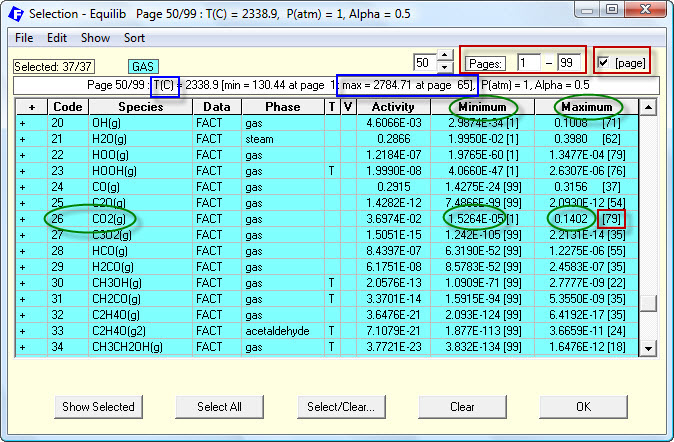
Like the Selection Window (see above), columns of the minimum and maximum values, etc. are now displayed.
Compounds and solutions that are selected for plotting are identified in the Post-Processor Species Selection Window.
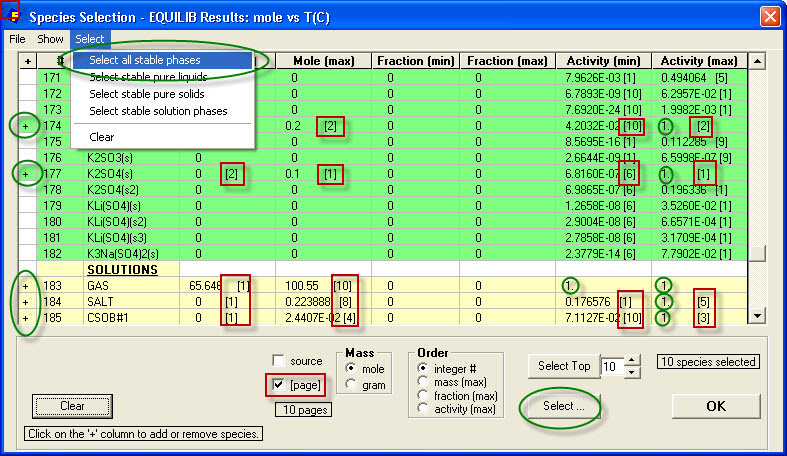
The metallurgical industry is increasingly using physically based models to simulate their process. The models rely on the use of high quality thermophysical property data. Direct measurement is expensive and effort recently has focused on the development of techniques for the prediction of thermodynamic, structural, physical and mechanical properties validated against experimental measurements on targeted materials.In order to provide such information to engineers we are developing a function builder software tools to predict how the processability properties of alloys vary.
We wish to include properties such as thermal conductivity, viscosity, surface tension, elastic properties, hardness, tensile strength, yield stress, Ms temperature, etc. in the optimizations. These properties depend upon: (1) variables which can be calculated by FactSage such as phase fractions and phase compositions after annealing and (2) variables which can be entered by the user for a particular situation such as cooling rate, grain size, rolling conditions, system dimensions, etc.
The “function builder” permits the user to enter an empirical function giving the properties as functions of the variables

The functions can contain expressions using values calculated by Equilib. These include thermochemical variables such as compound, solution and species activities, amounts, fractions, partial or integral properties; extensive properties such as temperature, pressure, volume, integral properties, etc. The functions can include the common mathematic operators * + - / () ^ abs, ln, log, exp, cos, sin, etc. as well as other functions.
For example, consider the dissolution of N2(gas) in Fe(liquid) at elevated temperatures:
½ N2(g) = N(% in Fe-liq)
The solubility of nitrogen can be represented by Sievert's law: %N = S.p(N2)1/2
where S, Sievert's parameter, is constant at a given temperature and moderate pressures.
You can employ the Fact-Function-Builder to automatically display S and log(S)
after each Equilib calculation
- see screen shots below where the functions are
f1 = S = %N/p(N2)1/2, and f1 = log(S) = log(f1).
Note: Fe-N_Sievert is the name of a functions group file created by the
Fact-XML function builder (not shown here).
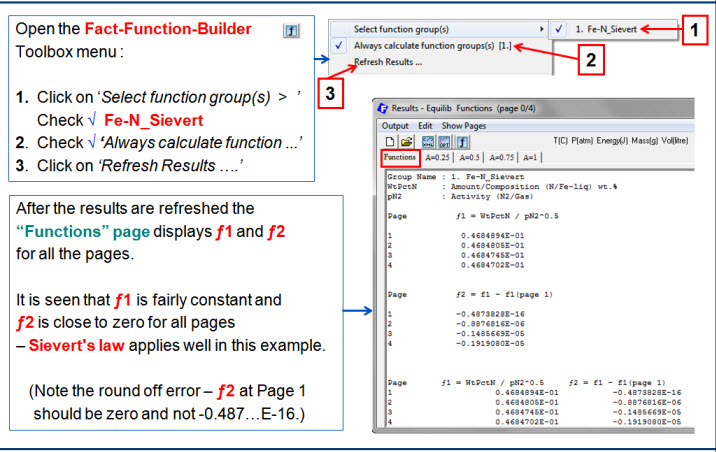
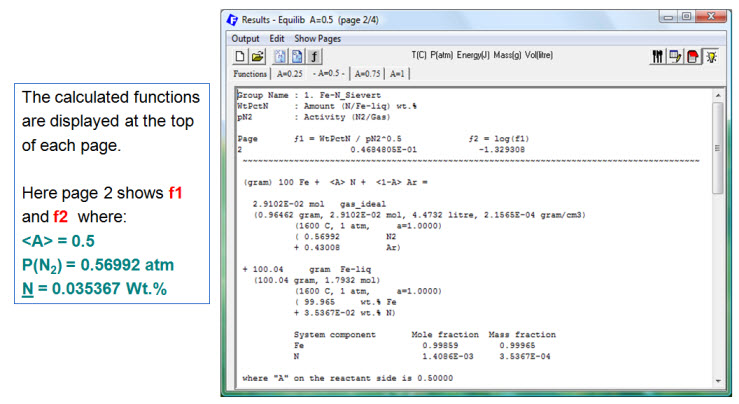
After an Equilib calculation you can also import the calculated functions into Fact-XML and manipulate the values in other ways - for example create graphs.
The function group file name (Fe-N_Sievert in the above example) can be saved with the system (e.g. in the Equi*.dat file) in which case it is automatically loaded the next time the Equi*.dat file is opened. Within each function group file the functions can be edited and displayed at any time. There is no limit to the number of functions in a functions group file nor the total number of such files.
Complete details are given in the Fact-Function-Builder slide show.
| 1. Beep when finished - it is now possible to issue a sound ('friendly beep' unique to Phase Diagram) when a calculated phase diagram is finished. This is useful in time consuming calculations when you want to know the moment the resulting diagram is ready. |
|
| 2. Intersection points - for polythermal projections, tabulated lists of intersecting phases, compositions and temperatures may be displayed on the calculated figure, or in a separate text window, or both. |
|
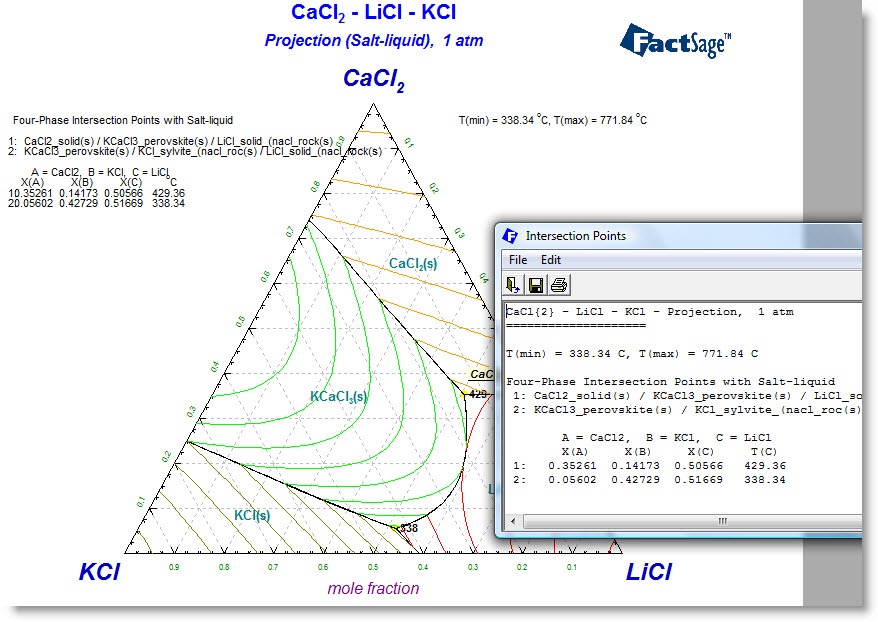
1. Volume diagrams
|
|
'Volume' or 'log volume' may be specified as an X- or Y-axis.
Typical volume diagrams include 'V (or log V) versus T' and 'V (or log V) versus X'. |
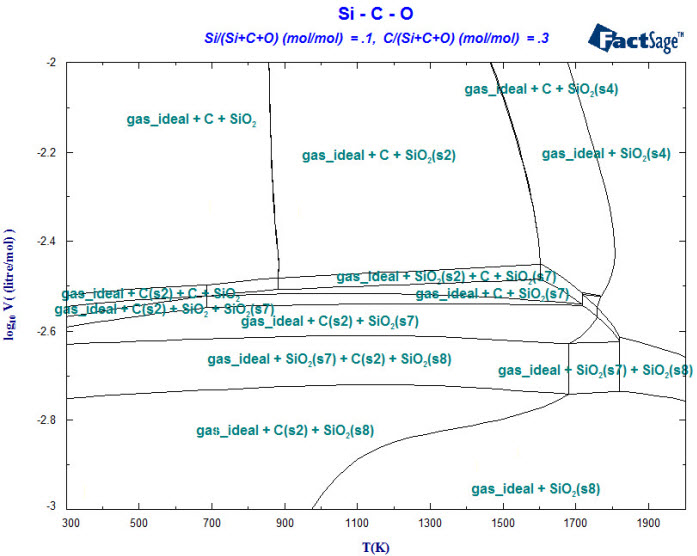
2. Polythermal Projections
|
2.1 Alloy Liquidus Projection from the SGTE 2011 Databases
Polythermal Projections were first introduced in FactSage 6.1. It is possible to calculate and plot polythermal projections of surfaces (typically the liquidus surface) of ternary (or reciprocal salt) systems. In the 'Temperature Frame' select 'projection' from the combo menu as shown in the screenshot. The screenshot shows option "Projection" selected in the Variables Window. |
|
|
In the Menu Window it is then necessary to identify the target solution phase
- typically a liquid solution (e.g. FToxid-slag, FTsalt-liquid) in the case of a liquidus projection.
This is done by assigning option "O" (Only plot this phase) for the target solution phase being selected. In FactSage 6.3 you can alternatively assign option "P" (precipitate target phase). That is, options "O" and "P" are equivalent. Liquidus projection - the screenshot shows option "P" assigned to the SGTE-liquid phase (e.g. mouse-right-click on the '+' column). |
|
For both ternary Gibbs phase diagram and X versus Y reciprocal systems, the polythermal projection of the liquidus surfaces will appear as a series of isothermal lines and univariant lines where the liquidus surfaces intersect.
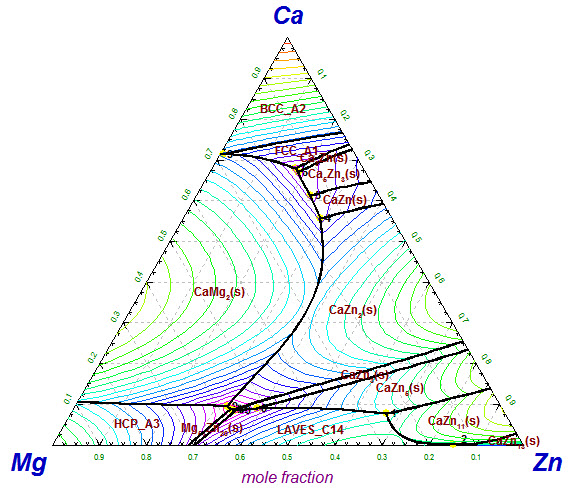
|
2.2 Alloy First Melting Projection from the SGTE 2011 Databases It is now possible to calculate and plot polythermal projections of a formation surface (typically the first melting or solidus surface) of ternary (or reciprocal salt) systems. In the 'Temperature Frame' of the Variables Window elect 'projection' from the combo menu as before. In the Menu Window it is then necessary to identify the formation target solution phase - typically a liquid solution (e.g. FToxid-slag, FTsalt-liquid) in the case of a first melting or solidus projection. This is done by assigning option "F" (formation target phase) for the target solution phase being selected. First melting projection - the screenshot shows option "F" assigned to the SGTE-liquid phase (e.g. mouse-right-click on the '+' column) |
|
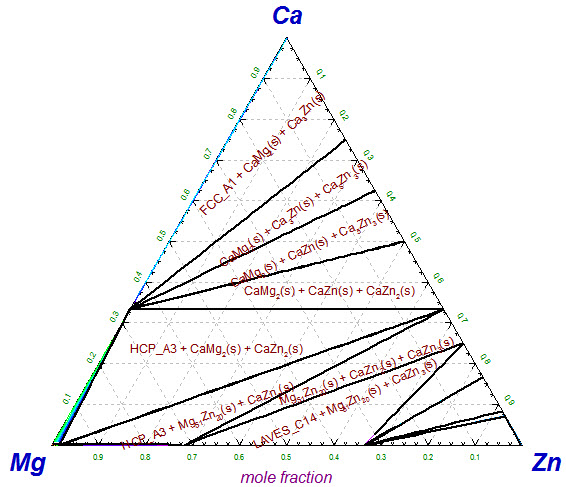
2.3 Oxide Liquidus and First Melting Projections from the FToxid databases
|
|
|
3. Eh - pH Pourbaix diagrams
For aqueous based phase diagrams Eh and pH may be specified as axes. Unlike the Eph module that is limited to compound data, here in Phase Diagram the resulting Pourbaix diagram can include solution phases (e.g. alloy, oxide, aqueous) from the solution databases.
The Eh-pH Pourbaix diagram includes initiation steps in the Components Window that are unique to this type of phase diagram.
|
|
|
| The axes and total molalities are specified in the Variables Window. |
|
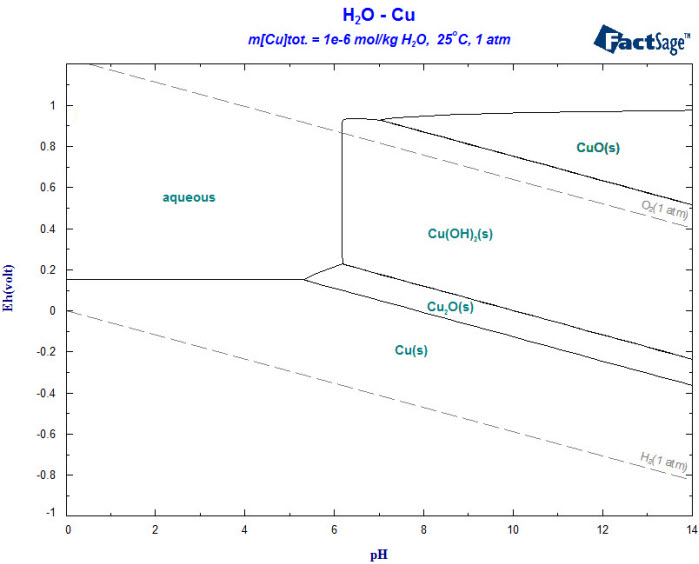
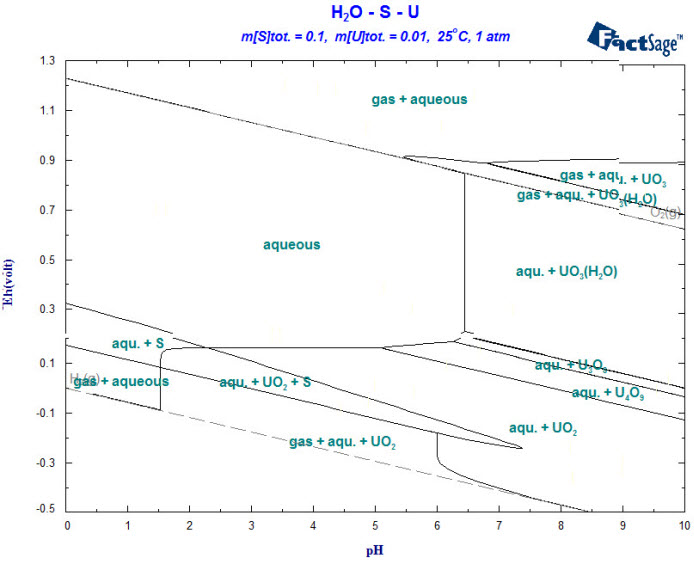
The melts viscosity data are valid for liquid and supercooled slags with viscosities which are not too high, that is when log10(viscosity, Poise) is less than about 7.5 or ln(viscosity, Pa·S) < 15. In most cases this corresponds to temperatures above about 900oC.
The melts viscosity data have been improved for the PbO-containing systems. In particular, the viscosity of lead crystal glass melts is described better.
The glass viscosity data can be used at and below the glass transition temperatures. In principle, these data are valid over the whole temperature range from liquid melts to glasses, but sometimes they may be slightly less accurate for liquid slags than the melts data.
The glass viscosity data have been completely reoptimized to improve the accuracy over the whole temperature range from liquid melts to glasses. However, the melts data are still more accurate than the glass data for temperatures above the liquidus.
| Al29Mg21 | Al8Mg5 | AlS (s,l) | |||
| Na2S3 | Nb4C3 | V5B6 |
| Al2 | Al2Ca | Al2O2 | |||
| Al2O3 | (Al2O3)(SiO2)2(H2O)2 | Al2Sr | |||
| Al3Ni | Al4Ca | Al4Ce | |||
| Al4Sr | Al7Sr8 | AlC | |||
| AlO2 | AuPb2 | AuSn | |||
| AuSn2 | B2Cr | B2Mn | |||
| B2Ti | B2V | B2V3 | |||
| B3V2 | B4V3 | BCr | |||
| BFe | BTi | BV | |||
| C3H4 | C3H6 | C4H8 | |||
| C5H8 | C6H12 | C7H14 | |||
| C8H10 | Ca(NO3)2 | Ca(NO3)2(H2O)2 | |||
| Ca(NO3)2(H2O)3 | Ca(NO3)2(H2O)4 | Ca2 | |||
| Ca2Si | Ca3(AsO4)2 | CaCO3 | |||
| CaSi | CaSi2 | CCl3Br | |||
| CF2CFCl | CF2CHCl | CH2CF2 | |||
| CNb | Co3Nb | Co3W | |||
| CoSi | Cr23C6 | Cr3C2 | |||
| Cr5Si3 | Cr7C3 | CrF2 | |||
| CrF3 | CTi | Cu2Mg | |||
| DOCl | Fe10S11 | Fe11S12 | |||
| Fe2B | Fe2P | Fe3C | |||
| Fe3P | Fe3Si7 | Fe7S8 | |||
| FeO4P | FeP | FeSi | |||
| FeSi2 | FeTi | GdCl3 | |||
| K2CrO4 | KAl(SO4)2 | KH2PO4 | |||
| KNO3 | Mg17Sr2 | Mg2 | |||
| Mg2Ca | Mg2Si | Mg2Sr | |||
| Mg23Sr6 | Mg38Sr9 | MgB2 | |||
| MgB4 | Mn3Si | Mn5Si3 | |||
| MnSi | Mo2B | Mo3Si | |||
| Mo5Si3 | MoB | MoB2 | |||
| MoB4 | MoC | MoF5 | |||
| N4Si3 | NaAlSi2O6 | Nb2C | |||
| (NH4)2SO4 | (NH4)H2PO4 | NH4Cl | |||
| NH4NO3 | Ni2Si | Ni3Ti | |||
| Ni4B3 | Ni4W | NiF2 | |||
| NiTi2 | O2F | P2S5 | |||
| PuF3 | PuF4 | Rb2O | |||
| Si2 | Si2C | Si2V | |||
| Si3 | Si3Ta5 | Si3V5 | |||
| SiC | SiC2 | SiO | |||
| SiO2 | SiTa2 | ThF4 | |||
| UF3 | UF4 | UF5 | |||
| WC |
| AgClO3 | Al2C2 | AlAsO4 | |||
| AlC2 | As4S4 | AsO | |||
| Au3AsO4 | Ba2Sn | Ba3(AsO4)2 | |||
| Be3(AsO4)2 | BiBr | Br2O | |||
| BrO2 | BrO3 | C12H4Cl4O2 | |||
| C2Cl | C2Cl3 | C2Cl5 | |||
| C2F | C2F2Cl2 | C2F3 | |||
| C2F5 | C2FCl | C2FCl3 | |||
| C2H2FCl | C2H3F | C2HFCl2 | |||
| Ca2Sn | CaAl2B2O7 | CaCN2 | |||
| CaHPO4 | CaSn | (CaSO3)2(H2O) | |||
| CBr2 | CBr2I2 | CBr3 | |||
| CBr3I | CBrI3 | CCl2Br2 | |||
| CCl2BrI | CCl2I2 | CCl3I | |||
| CClBr2I | CClBr3 | CClBrI2 | |||
| CClI3 | CF2Br2 | CF2BrI | |||
| CF2Cl | CF2ClBr | CF2ClI | |||
| CF2I2 | CFBr2I | CFBr3 | |||
| CFBrI2 | CFCl | CFCl2 | |||
| CFCl2Br | CFCl2I | CFClBr2 | |||
| CFClBrI | CFClI2 | CFI3 | |||
| CH2Br2 | CH2BrI | CH2Cl | |||
| CH2ClBr | CH2ClI | CH2F | |||
| CH2FBr | CH2FI | CH3O | |||
| CHBr2I | CHBrI2 | CHCl2 | |||
| CHCl2Br | CHCl2I | CHClBr2 | |||
| CHClBrI | CHClI2 | CHF2 | |||
| CHF2Br | CHF2I | CHFBr2 | |||
| CHFBrI | CHFCl | CHFClBr | |||
| CHFClI | CHFI2 | Cl2O2 | |||
| ClO3 | COOH | Cr3(AsO4)2 | |||
| CrAsO4 | CrBr3 | CrBr4 | |||
| CrNaO2 | Cs3AsO4 | Cu3AsO4 | |||
| Cu3Br3 | Cu3I3 | CuMoO4 | |||
| DyBr3 | DyF3 | DyI3 | |||
| ErBr3 | ErF3 | ErI3 | |||
| EuBr2 | EuBr3 | EuF3 | |||
| F2O2 | Fe(VO3)2 | Fe3(AsO4)2 | |||
| FeAsO4 | FeNaO2 | FeV2O4 | |||
| Ga2Cl6 | GaAsO4 | GaCl2 | |||
| GaF | GaF2 | GdBr3 | |||
| GdF3 | GeCl2 | GeCl3 | |||
| GeF | GeF3 | HCCN | |||
| HClCO | HfBr4 | HfI4 | |||
| Hg3(AsO4)2 | HoBr3 | I2O | |||
| In2Cl6 | In2O | InAsO4 | |||
| InF | InF2 | InF3 | |||
| IO2 | IO3 | K3Al2Cl9 | |||
| K3AlCl6 | K3AsO4 | K4Ca(NO3)6 | |||
| KAl(SO4)2(H2O)3 | KCa(NO3)3(H2O)3 | KCa5(NO3)11(H2O)10 | |||
| LaAsO4 | Li2NiF4 | Li3AsO4 | |||
| Li3CrF6 | Li3PuF7 | Li3ThF7 | |||
| Li3UF7 | Li4PuF8 | Li4UF8 | |||
| Li7Pu6F31 | Li7Th6F31 | Li7U6F31 | |||
| LiAlSi2O6 | LiAlSiO4 | LiFeO2 | |||
| LiPu2F9 | LiPu4F17 | LiTh2F9 | |||
| LiTh4F17 | LiU2F9 | LiU4F17 | |||
| Mg(NO3)2 | Mg3(AsO4)2 | Mn2P | |||
| Mn3(AsO4)2 | Mo4O11 | Mo8O23 | |||
| Mo9O26 | MoAsO4 | Na3AlCl6 | |||
| Na3AsO4 | Na3VO4 | NaVO3 | |||
| NdBr3 | (NH4)4SO4(NO3)2 | (NH4)5SO4(NO3)3 | |||
| (NH4Cl)3NaNO3 | Ni20Se21 | Pb2I4 | |||
| Pb3(AsO4)2 | PrBr3 | PrF3 | |||
| Rb2SO4 | Rb3AsO4 | (RbCl)2 | |||
| (RbF)2 | RbO2 | ReAsO4 | |||
| RhCl2 | Sb2S4 | Sb3S2 | |||
| Sb4S3 | SbCl | SbF | |||
| SbO | ScAsO4 | Sn3(AsO4)2 | |||
| SnCl | SnF | SnF2 | |||
| (SnI2)2 | SnI4 | TaCl | |||
| TaCl2 | TbBr3 | TmBr3 | |||
| TmF3 | TmI3 | UBr5 | |||
| UO2(NO3)2 | UO2SO4 | W10O29 | |||
| W18O49 | Zn3(PO4)2 |
The FTfrtz compounds and solutions contain data for 26 pure salts and 14 salt solutions based on the family of ammonium nitrate (NH4NO3), ammonium di-hydrogen phosphate (NH4H2PO4), ammonium chloride (NH4Cl) and ammonium sulfate ((NH4)2SO4). fertilizers with additions of their corresponding potassium salts (and in some cases sodium salts). The model covers the addition of roughly up to 50 wt.% water (H2O).
C-Zr, Hf-Nb, Hf-V, Hf-W, Hf-Zr, Nb-Ta, Ta-V, Ta-Zr, Ti-Zr, V-W, V-Zr, W-Zr
and for the following ternary and quaternary systems:
Al-C-Fe, Al-C-Mn, Al-C-Fe-Mn, C-Hf-Nb, C-Hf-W, C-Nb-Ta, C-Nb-Ti, C-Nb-V, C-Nb-W, C-Nb-Zr, C-Ta-W, C-Ti-W, C-V-W, C-W-Zr.
Parameters for the Cd-Pb system have been revised.
|
|
FactPS, ELEM and SGPS are compounds-only databases. |
The following displays are only available if you have updated your installation with that particular version.
What's New in: